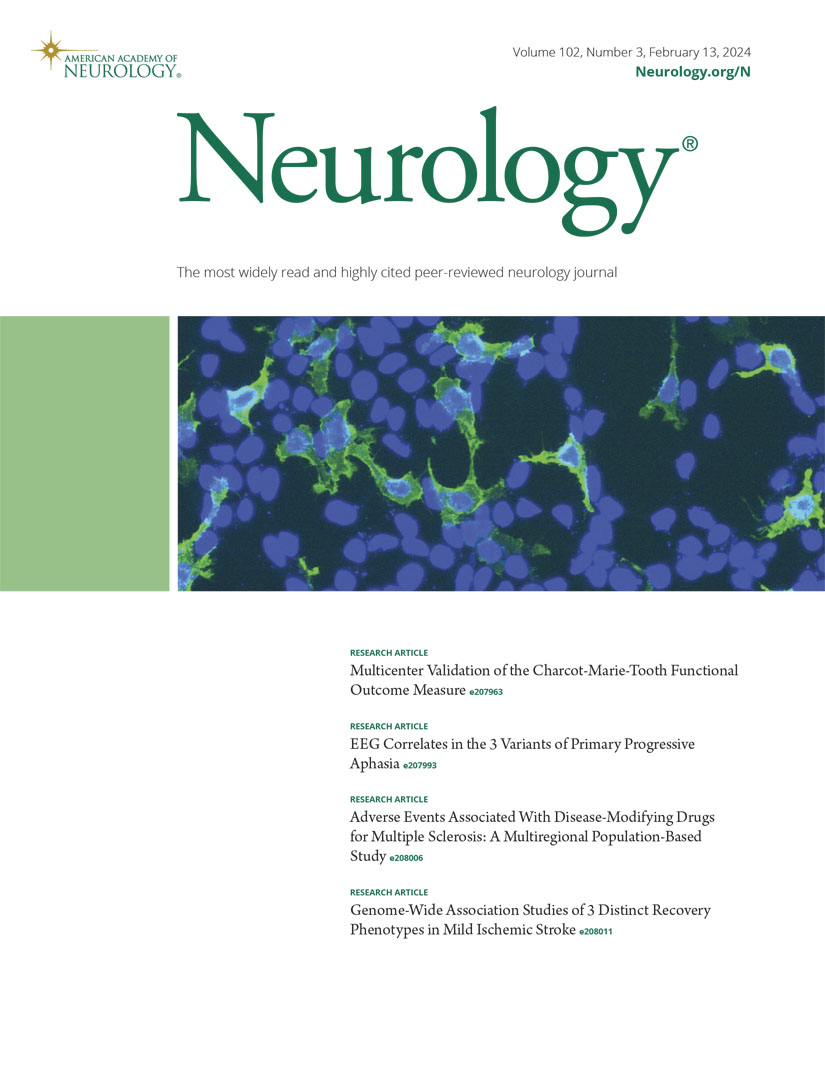鹿特丹研究中APOE ε4基因型、认知和痴呆的神经病理成像标志物的中介作用
IF 7.7
1区 医学
Q1 CLINICAL NEUROLOGY
引用次数: 0
摘要
背景与目的了解apoe相关通路对于揭示老年认知衰退的病理生理学和确定治疗靶点具有重要意义。我们的目的是通过体内结构脑成像的不同疾病标志物来估计APOE ε4对认知和痴呆的调节因子。方法纳入2005年至2009年间接受脑MRI的鹿特丹人群研究的所有参与者。在中心访问期间,对认知进行了横断面评估,并对参与者进行了痴呆事件随访,直到2020年1月1日。成像标记包括海马体积(HV)、白质高信号体积(WMHs)、阿尔茨海默病特异性区域皮质厚度和存在≥2个脑微出血。我们进行因果中介分析,将APOE ε4携带者对认知和痴呆的总影响分解为自然直接效应和间接效应以及相应的介导百分比。我们针对潜在的混杂因素调整了模型。结果5510名参与者(MRI扫描时平均年龄65.0[±10.9]岁,女性55.0%)中,349人发生痴呆,其中148人为ε4携带者。ε4携带者整体认知的z -score (β = -0.02[-0.07 ~ 0.02],与年龄相关的认知衰退= 4.4个月)略低,其中7% (β = -0.00[0.00-0.00])与HV相关,4% (β = -0.00[-0.01 ~ 0.00])与皮质厚度相关。总的来说,估计ε4对认知的影响有25%是由微出血介导的(p值= 0.24,[β = -0.00{-0.01至0.00}]),12%是由WMHs介导的(p值= 0.44,[β = -0.00{-0.01至0.00}])。在多介质分析中,wmh和微出血共同占APOE ε4对认知的介导效应的27% (p值= 0.48)。ε4携带者发生痴呆的风险较高(HR 2.35 [95% CI 2.06-2.65])。对于痴呆,几乎没有证据表明HV (3%, p值= 0.09,OR = 1.01[1.00-1.03])或区域皮质厚度(0%,p值= 0.79,OR = 1.00[0.99-1.02])起到中介作用。总的来说,ε4对痴呆的影响有1%是由wmh介导的(p值0.29,OR = 1.00[1.00-1.02]), 5%是由微出血介导的(p值= 0.06),OR = 1.03(1.00-1.07)。在多中介分析中,所有4种影像学标记加起来解释了6%的痴呆事件的中介效应(p值= 0.04)。在这项基于人群的队列研究中,我们发现APOE ε4对认知的影响估计有四分之一是由脑结构成像标记介导的,主要由脑微出血驱动。对于痴呆症,这些标记物的调节作用有限。本文章由计算机程序翻译,如有差异,请以英文原文为准。
Mediation of the Association Between APOE ε4 Genotype, Cognition, and Dementia by Neuropathology Imaging Markers in the Rotterdam Study.
BACKGROUND AND OBJECTIVES
Insight into APOE-related pathways is important to unravel pathophysiology and identify therapeutic targets against late-life cognitive decline. We aimed to estimate mediators of APOE ε4 on cognition and dementia through different disease markers on structural in vivo brain imaging.
METHODS
All participants from the population-based Rotterdam Study who underwent brain MRI between 2005 and 2009 were included. Cognition was assessed cross-sectionally during center visits, and participants were followed up for incident dementia until January 1, 2020. Imaging markers included hippocampal volume (HV), volume of white matter hyperintensities (WMHs), Alzheimer disease-specific regional cortical thickness, and presence of ≥2 cerebral microbleeds. We performed causal mediation analyses to decompose the total effect of APOE ε4 carriership on cognition and dementia into natural direct and indirect effects and corresponding percentage mediated. We adjusted models for potential confounders.
RESULTS
Among 5,510 participants (mean age at time of MRI scan: 65.0 [±10.9] years, 55.0% women), 349 developed dementia, of whom 148 were ε4 carriers. Carriers of ε4 had slightly lower Z-scores for global cognition (β = -0.02 [-0.07 to 0.02], age-related cognitive decline = 4.4 months), with 7% (β = -0.00 [0.00-0.00]) of this association mediated by HV and 4% (β = -0.00 [-0.01 to 0.00]) by cortical thickness. In total, an estimated 25% of the effect of ε4 on cognition was mediated by microbleeds (p value = 0.24, [β = -0.00 {-0.01 to 0.00}]) and 12% by WMHs (p value = 0.44, [β = -0.00 {-0.01 to 0.00}]). In multiple mediator analyses, WMHs and microbleeds together accounted for 27% of the mediated effect of APOE ε4 on cognition (p value = 0.48). Carriers of ε4 had higher risk of incident dementia (HR 2.35 [95% CI 2.06-2.65]). For dementia, there was little to no evidence of mediation by either HV (3%, p value = 0.09, OR = 1.01 [1.00-1.03]) or regional cortical thickness (0%, p value = 0.79, OR = 1.00 [0.99-1.02]). In total, 1% of the effect of ε4 on dementia was mediated by WMHs (p value 0.29, OR = 1.00 [1.00-1.02]) and 5% by microbleeds (p value = 0.06), OR = 1.03 (1.00-1.07). In multiple mediator analyses, all 4 imaging markers together explained 6% of the mediated effect on incident dementia (p value = 0.04).
DISCUSSION
In this population-based cohort study, we found that an estimated one-fourth of the effect of APOE ε4 on cognition is mediated by structural brain imaging markers, driven mainly by cerebral microbleeds. For dementia, mediation by these markers was limited.
求助全文
通过发布文献求助,成功后即可免费获取论文全文。
去求助
来源期刊

Neurology
医学-临床神经学
CiteScore
12.20
自引率
4.00%
发文量
1973
审稿时长
2-3 weeks
期刊介绍:
Neurology, the official journal of the American Academy of Neurology, aspires to be the premier peer-reviewed journal for clinical neurology research. Its mission is to publish exceptional peer-reviewed original research articles, editorials, and reviews to improve patient care, education, clinical research, and professionalism in neurology.
As the leading clinical neurology journal worldwide, Neurology targets physicians specializing in nervous system diseases and conditions. It aims to advance the field by presenting new basic and clinical research that influences neurological practice. The journal is a leading source of cutting-edge, peer-reviewed information for the neurology community worldwide. Editorial content includes Research, Clinical/Scientific Notes, Views, Historical Neurology, NeuroImages, Humanities, Letters, and position papers from the American Academy of Neurology. The online version is considered the definitive version, encompassing all available content.
Neurology is indexed in prestigious databases such as MEDLINE/PubMed, Embase, Scopus, Biological Abstracts®, PsycINFO®, Current Contents®, Web of Science®, CrossRef, and Google Scholar.
 求助内容:
求助内容: 应助结果提醒方式:
应助结果提醒方式:


